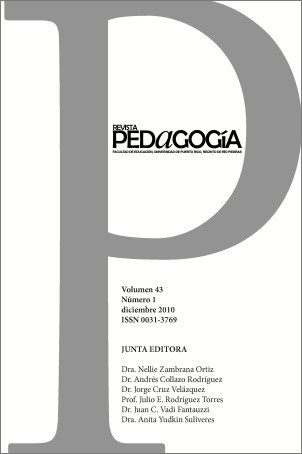Abstract
This article summarizes the evidence collected since the 1970s againts algorithm teaching, in order to promote the contrary: encounraging children to execute their thinking about arithmetic problems in order to construct knowledge. The harmful effects of teaching "carrying" and "borrowing" were demonstrated by asking second, third, and fourth graders to mentally solve problems like 7 + 52 + 186. The children who had not been taught these algorithms gave correct answers much more frequently, and the errors they make were much more reasonable (e.g., 235) than the errors made by students who were taught these rules (e.g., 989 and 29). It was concluded that teaching these rules is harmful to the great majority of students because (a) it makes students give up their own thinking, and (b) it "unteaches" place value.
How to cite:
Kamii, C., & Dominick, A. (2011). Los efectos negativos de enseñar algoritmos en grados primarios (1ro al 4to). (Trad. N. Zambrana). Pedagogía, 43(1), 59-73. Retrieved from https://revistas.upr.edu/index.php/educacion/article/view/16574
References
Ashlock, R.B. (1982). Error patterns in computation. Columbus, OH: Charles E. Merrill Publishing.
Brown, J.S., & Burton, R.R. (1978). Diagnostic models for procedural bugs in basic mathematical skills. Cognitive Science, 2, 155-192.
Burns, M. (1994). Arithmetic: The last holdout. Phi Delta Kappan, 75, 471-476.
Carraher, T.N., Carraher, D.W., & Schliemann, A.D. (1985). Mathematics in the streets and in school. British Journal of Developmental Psychology, 3, 21-29.
Carraher, T., & Schliemann, A.D. (1985). Computation routines prescribed by schools: Help or Hindrance? Journal for Research in Mathematics Education, 16, 37-44.
Cochran, B. S., Barson, A., & Davis, R.B. (1970). Child-created mathematics. Arithmetic Teacher, 17, 211-15.
Dominick, A.M. (1991). Third graders‘ understanding of the multidigit subtraction algorithm (Unpublished doctoral dissertation). Tennessee: Vanderbilt University.
Ferreiro, E. (1988). Alfabetizacāo em processo. Sāo Paulo: Cortez.
Groza, V.S. (1968). A survey of mathemathics: Elementary concepts and their historical development. New York: Holt, Rinehart & Winston.
Jones, D.A. (1975, May). Don‘t just mark the answer – Have a look at the method! Mathematics in School, 4, 29-31.
Kamii, C. (1985). Young children reinvent arithmetic. New York: Teachers College Press.
Kamii, C. (1989a). Double-digit addition: A teacher uses Piaget‘s theory (videotape). New York: Teachers College Press.
Kamii, C. (1989b). Young children continue to reinvent arithmetic, 2nd grade. New York: Teachers College Press.
Kamii, C. (1994). Young children continue to reinvent arithmetic, 3rd grade. New York: Teachers College Press.
Leinwand, S. (1994, February). It‘s time to abandon computational algorithms. Education Week, 9, 36.
Madell, R. (1985). Children‘s natural processes. Arithmetic Teacher, 32, 20-22.
Murray, H., & Olivier, A. (1989). A model of understanding two-digit numeration and computation. In G. Vergnaud, J. Rogalski, & M. Artigue (Eds), Proceedings of the Thirteenth Meeting of the International Group for the Psychology of Mathematics Education (pp. 3-10). Paris: Laboratoire PSYDEE of the National Center of Scientific Research.
Narode, R., Board, J., & Davenport, L. (1993). Algorithms supplant understanding: Case studies of primary student‘s strategies for double-digit addition and subtraction. In J. Rossi Becker, & B. J. Pence (Eds.), Proceedings of the Fifteenth Annual Meeting, North American Chapter of the International Group for the Psychology of Mathematics Education, Vol. 1 (pp. 254-60). CA: San Jose State University, Center for Mathematics and Computer Science Education.
Plunkett, S. (1979). Decomposition and all that rot. Mathematics in School, 8(3), 2-7.
ter Heege, H. (1978). Testing the maturity for learning the algorithm of multiplication. Educational Studies in Mathematics, 9, 75-83.
Vakali, M. (1984). Children‘s thinking in arithmetic word problem solving. Journal of Experimental Education, 53, 106-13.
The contents published in the Puerto Rico Journal of Education is freely distributed under open access practices, in accordance with the Creative Commons license, Attribution-NonCommercial 4.0 International (CC BY-NC 4.0). Through these principles, the journal and its authors allow readers to access, reproduce and share articles in full text. Users should give credit to authors in a reasonable way without suggesting they have their support. Under no circumstances, readers may make use of the contents for commercial purposes. The authors retain copyright on their works.

